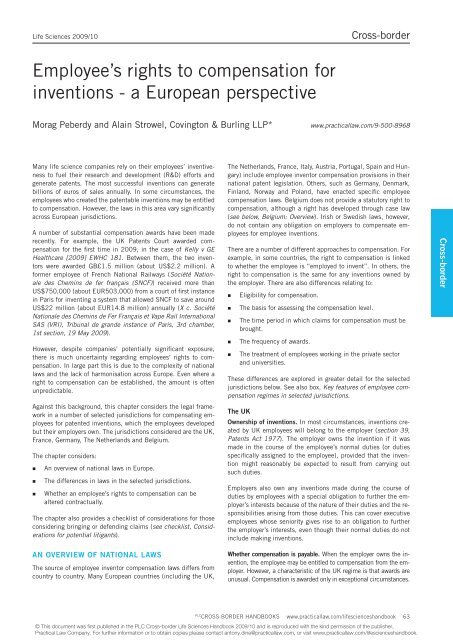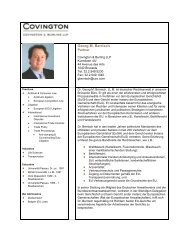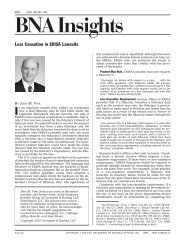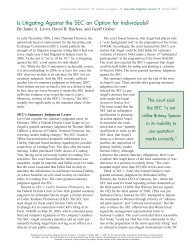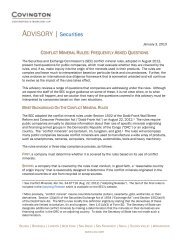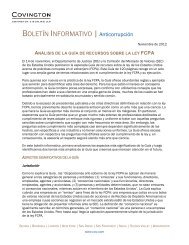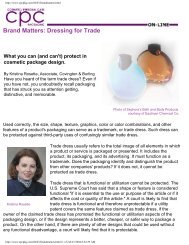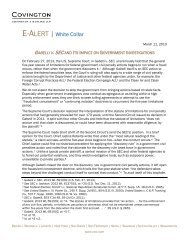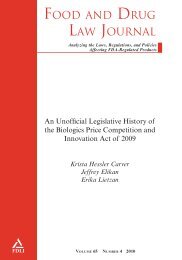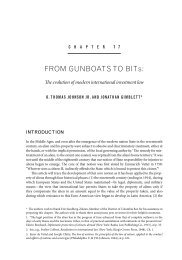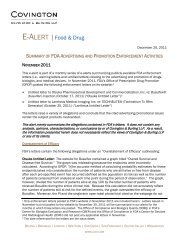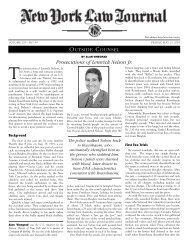Employee's rights to compensation for inventions - Covington ...
Employee's rights to compensation for inventions - Covington ...
Employee's rights to compensation for inventions - Covington ...
Create successful ePaper yourself
Turn your PDF publications into a flip-book with our unique Google optimized e-Paper software.
Life Sciences 2009/10<br />
Employee’s <strong>rights</strong> <strong>to</strong> <strong>compensation</strong> <strong>for</strong><br />
<strong>inventions</strong> - a European perspective<br />
Cross-border<br />
Morag Peberdy and Alain Strowel, Coving<strong>to</strong>n & Burling LLP* www.practicallaw.com/9-500-8968<br />
Many life science companies rely on their employees’ inventiveness<br />
<strong>to</strong> fuel their research and development (R&D) ef<strong>for</strong>ts and<br />
generate patents. The most successful <strong>inventions</strong> can generate<br />
billions of euros of sales annually. In some circumstances, the<br />
employees who created the patentable <strong>inventions</strong> may be entitled<br />
<strong>to</strong> <strong>compensation</strong>. However, the laws in this area vary significantly<br />
across European jurisdictions.<br />
A number of substantial <strong>compensation</strong> awards have been made<br />
recently. For example, the UK Patents Court awarded <strong>compensation</strong><br />
<strong>for</strong> the first time in 2009, in the case of Kelly v GE<br />
Healthcare [2009] EWHC 181. Between them, the two inven<strong>to</strong>rs<br />
were awarded GB£1.5 million (about US$2.2 million). A<br />
<strong>for</strong>mer employee of French National Railways (Société Nationale<br />
des Chemins de fer français (SNCF)) received more than<br />
US$750,000 (about EUR503,000) from a court of first instance<br />
in Paris <strong>for</strong> inventing a system that allowed SNCF <strong>to</strong> save around<br />
US$22 million (about EUR14.8 million) annually (X c. Société<br />
Nationale des Chemins de Fer Français et Vape Rail International<br />
SAS (VRI), Tribunal de grande instance of Paris, 3rd chamber,<br />
1st section, 19 May 2009).<br />
However, despite companies’ potentially significant exposure,<br />
there is much uncertainty regarding employees’ <strong>rights</strong> <strong>to</strong> <strong>compensation</strong>.<br />
In large part this is due <strong>to</strong> the complexity of national<br />
laws and the lack of harmonisation across Europe. Even where a<br />
right <strong>to</strong> <strong>compensation</strong> can be established, the amount is often<br />
unpredictable.<br />
Against this background, this chapter considers the legal framework<br />
in a number of selected jurisdictions <strong>for</strong> compensating employees<br />
<strong>for</strong> patented <strong>inventions</strong>, which the employees developed<br />
but their employers own. The jurisdictions considered are the UK,<br />
France, Germany, The Netherlands and Belgium.<br />
The chapter considers:<br />
An overview of national laws in Europe.<br />
The differences in laws in the selected jurisdictions.<br />
Whether an employee’s <strong>rights</strong> <strong>to</strong> <strong>compensation</strong> can be<br />
altered contractually.<br />
The chapter also provides a checklist of considerations <strong>for</strong> those<br />
considering bringing or defending claims (see checklist, Considerations<br />
<strong>for</strong> potential litigants).<br />
An overview of nAtionAl lAws<br />
The source of employee inven<strong>to</strong>r <strong>compensation</strong> laws differs from<br />
country <strong>to</strong> country. Many European countries (including the UK,<br />
The Netherlands, France, Italy, Austria, Portugal, Spain and Hungary)<br />
include employee inven<strong>to</strong>r <strong>compensation</strong> provisions in their<br />
national patent legislation. Others, such as Germany, Denmark,<br />
Finland, Norway and Poland, have enacted specific employee<br />
<strong>compensation</strong> laws. Belgium does not provide a statu<strong>to</strong>ry right <strong>to</strong><br />
<strong>compensation</strong>, although a right has developed through case law<br />
(see below, Belgium: Overview). Irish or Swedish laws, however,<br />
do not contain any obligation on employers <strong>to</strong> compensate employees<br />
<strong>for</strong> employee <strong>inventions</strong>.<br />
There are a number of different approaches <strong>to</strong> <strong>compensation</strong>. For<br />
example, in some countries, the right <strong>to</strong> <strong>compensation</strong> is linked<br />
<strong>to</strong> whether the employee is “employed <strong>to</strong> invent”. In others, the<br />
right <strong>to</strong> <strong>compensation</strong> is the same <strong>for</strong> any <strong>inventions</strong> owned by<br />
the employer. There are also differences relating <strong>to</strong>:<br />
Eligibility <strong>for</strong> <strong>compensation</strong>.<br />
The basis <strong>for</strong> assessing the <strong>compensation</strong> level.<br />
The time period in which claims <strong>for</strong> <strong>compensation</strong> must be<br />
brought.<br />
The frequency of awards.<br />
The treatment of employees working in the private sec<strong>to</strong>r<br />
and universities.<br />
These differences are explored in greater detail <strong>for</strong> the selected<br />
jurisdictions below. See also box, Key features of employee <strong>compensation</strong><br />
regimes in selected jurisdictions.<br />
the UK<br />
ownership of <strong>inventions</strong>. In most circumstances, <strong>inventions</strong> created<br />
by UK employees will belong <strong>to</strong> the employer (section 39,<br />
Patents Act 1977). The employer owns the invention if it was<br />
made in the course of the employee’s normal duties (or duties<br />
specifically assigned <strong>to</strong> the employee), provided that the invention<br />
might reasonably be expected <strong>to</strong> result from carrying out<br />
such duties.<br />
Employers also own any <strong>inventions</strong> made during the course of<br />
duties by employees with a special obligation <strong>to</strong> further the employer’s<br />
interests because of the nature of their duties and the responsibilities<br />
arising from those duties. This can cover executive<br />
employees whose seniority gives rise <strong>to</strong> an obligation <strong>to</strong> further<br />
the employer’s interests, even though their normal duties do not<br />
include making <strong>inventions</strong>.<br />
whether <strong>compensation</strong> is payable. When the employer owns the invention,<br />
the employee may be entitled <strong>to</strong> <strong>compensation</strong> from the employer.<br />
However, a characteristic of the UK regime is that awards are<br />
unusual. Compensation is awarded only in exceptional circumstances.<br />
PLC CROSS-BORDER HANDBOOKS www.practicallaw.com/lifescienceshandbook 63<br />
© This document was first published in the PLC Cross-border Life Sciences Handbook 2009/10 and is reproduced with the kind permission of the publisher,<br />
Practical Law Company. For further in<strong>for</strong>mation or <strong>to</strong> obtain copies please contact an<strong>to</strong>ny.dine@practicallaw.com, or visit www.practicallaw.com/lifescienceshandbook.<br />
Cross-border
Cross-border<br />
Cross-border<br />
64 PLC CROSS-BORDER HANDBOOKS www.practicallaw.com/lifescienceshandbook<br />
Life Sciences 2009/10<br />
Key feAtUres of employee CompensAtion regimes in seleCted jUrisdiCtions<br />
feAtUre UK BelgiUm frAnCe germAny the<br />
netherlAnds<br />
relevant<br />
legislation<br />
Underlying<br />
rationale<br />
requirements<br />
<strong>for</strong><br />
entitlement<br />
Sections 40 <strong>to</strong> 42,<br />
Patents Act 1977.<br />
Compensating inven<strong>to</strong>rs<br />
in exceptional<br />
circumstances if both:<br />
The patent (and/<br />
or, <strong>for</strong> patents filed<br />
in 2005 or later,<br />
the invention) has<br />
been of outstanding<br />
benefit <strong>to</strong> the<br />
employer.<br />
There is a real disparity<br />
between the<br />
benefits received<br />
by the employer<br />
and the employee.<br />
The patent (and/<br />
or, <strong>for</strong> patents filed<br />
in 2005 or later,<br />
the invention) is of<br />
outstanding benefit<br />
<strong>to</strong> the employer, and<br />
it is “just” <strong>for</strong> the<br />
employer <strong>to</strong> pay<br />
<strong>compensation</strong>.<br />
There are no statu<strong>to</strong>ry<br />
rules regarding<br />
employee <strong>inventions</strong>.<br />
Compensation can<br />
be awarded by the<br />
courts in rather<br />
exceptional cases.<br />
No entitlement <strong>to</strong><br />
<strong>compensation</strong> <strong>for</strong><br />
“service <strong>inventions</strong>”<br />
(made within the<br />
scope of the employment<br />
contract).<br />
Possible entitlement<br />
<strong>to</strong> <strong>compensation</strong> <strong>for</strong><br />
“mixed <strong>inventions</strong>”<br />
(made outside the<br />
scope of the employment<br />
but with a<br />
connection <strong>to</strong> it).<br />
The applicable test depends on when the patent was filed. For<br />
patents filed be<strong>for</strong>e 1 January 2005, <strong>compensation</strong> is available<br />
if both:<br />
The patent is of an outstanding benefit <strong>to</strong> the employer.<br />
Benefits from <strong>for</strong>eign patents can be taken in<strong>to</strong> account.<br />
The process used <strong>to</strong> determine whether there has been an<br />
outstanding benefit is:<br />
showing a causal link between the patent and the benefit.<br />
There is no requirement that the patent be the only<br />
cause of the benefit;<br />
assessing the level of relevant benefit. For pre-2005<br />
patents, only the benefit attributable <strong>to</strong> the patent is<br />
assessed. The actual benefits derived from the patented<br />
Patent Act 1978,<br />
as codified by the<br />
Intellectual Property<br />
Code 1992.<br />
Compensation must<br />
be awarded <strong>for</strong> all<br />
employee <strong>inventions</strong><br />
that the employer<br />
owns.<br />
Entitlement <strong>to</strong> additional<br />
remuneration<br />
(rémunération supplémentaire)<br />
<strong>for</strong> <strong>inventions</strong><br />
made within the<br />
scope of employment<br />
(invention de mission<br />
attribuable).<br />
Entitlement <strong>to</strong> fair<br />
<strong>compensation</strong> (juste<br />
prix) <strong>for</strong> <strong>inventions</strong><br />
outside employee’s<br />
normal duties (invention<br />
hors mission<br />
attribuable) if the<br />
employer claims<br />
ownership.<br />
Employees Inventions<br />
Act 1957<br />
(Arbeitnehmererfindungen)<br />
(ArbnErfG)<br />
and guidelines issued<br />
by the Minister<br />
of Labour.<br />
Compensation must<br />
be awarded <strong>for</strong> all<br />
service <strong>inventions</strong><br />
claimed by the<br />
employer.<br />
Au<strong>to</strong>matic entitlement<br />
<strong>to</strong> reasonable<br />
<strong>compensation</strong> if<br />
the employer has<br />
exercised its right <strong>to</strong><br />
take ownership of a<br />
service invention.<br />
Article 12, Patent<br />
Act 1995<br />
Compensation<br />
should only be<br />
awarded if the inven<strong>to</strong>r<br />
has not already<br />
been compensated<br />
<strong>for</strong> the patent in his<br />
salary, pecuniary allowance<br />
or any other<br />
extra remuneration.<br />
Entitlement <strong>to</strong> equitable<br />
remuneration if<br />
the existing contractual<br />
remuneration is<br />
deemed insufficient.<br />
Courts have been<br />
reluctant <strong>to</strong> find<br />
this, particularly in<br />
relation <strong>to</strong> large,<br />
industrial employers.<br />
invention are compared with the hypothetical benefits<br />
which might have accrued if the product or process had<br />
been sold in the absence of patent protection;<br />
determining whether the benefit is “outstanding”. The<br />
courts have resisted defining “outstanding”, beyond<br />
agreeing that it means “something special” or “out of<br />
the ordinary”, and more than “substantial”, “significant”<br />
or “good”. The benefit must go beyond what one would<br />
normally expect <strong>to</strong> arise from the employee’s duties. The<br />
benefit itself must be “in money or money’s worth”, and<br />
so does not extend <strong>to</strong> reputational benefit. In assessing<br />
the benefit, all relevant fac<strong>to</strong>rs must be considered,<br />
particularly the employer’s size and nature.<br />
© This document was first published in the PLC Cross-border Life Sciences Handbook 2009/10 and is reproduced with the kind permission of the publisher,<br />
Practical Law Company. For further in<strong>for</strong>mation or <strong>to</strong> obtain copies please contact an<strong>to</strong>ny.dine@practicallaw.com, or visit www.practicallaw.com/lifescienceshandbook.
Life Sciences 2009/10<br />
It is “just” (that is, fair) <strong>to</strong> award <strong>compensation</strong>. The award is<br />
discretionary, and the court considers all factual issues. However,<br />
it is a low hurdle and this requirement will commonly be<br />
met if an outstanding benefit <strong>to</strong> the employer has been proved.<br />
In Kelly, an award was just even though only two of the three<br />
inven<strong>to</strong>rs had made a claim, the limitation period had nearly<br />
expired, and the claimants had waited a number of years<br />
after leaving employment be<strong>for</strong>e making a claim (see box,<br />
Kelly v GE Healthcare). It is possible that an award of further<br />
<strong>compensation</strong> may be unjust if the employer has already paid<br />
an incentive or a bonus payment <strong>to</strong> the employee <strong>for</strong> the invention,<br />
although this issue was not considered in Kelly.<br />
The first limb of the test is now different <strong>for</strong> patents filed on or<br />
after 1 January 2005. The benefit of the invention, and not just<br />
the patent, can be taken in<strong>to</strong> account <strong>for</strong> those patents. In certain<br />
Cross-border<br />
Key feAtUres of employee CompensAtion regimes in seleCted jUrisdiCtions<br />
feAtUre UK BelgiUm frAnCe germAny the<br />
netherlAnds<br />
valuing the<br />
benefit<br />
Calculation of<br />
<strong>compensation</strong><br />
time frame<br />
<strong>for</strong> claims<br />
The value is calculated<br />
after the patent<br />
has been exploited,<br />
by considering all<br />
available evidence.<br />
The employee is entitled<br />
<strong>to</strong> a fair share<br />
of the benefit which<br />
the employer has<br />
derived, or may reasonably<br />
be expected<br />
<strong>to</strong> derive.<br />
Determining a fair<br />
share is complex,<br />
and involves assessing<br />
a large number<br />
of fac<strong>to</strong>rs.<br />
Any time from the<br />
date of the grant of<br />
the patent until 1<br />
year after the patent<br />
has expired.<br />
The courts will assess<br />
<strong>compensation</strong><br />
taking in<strong>to</strong> account<br />
all circumstances of<br />
the case.<br />
The claim must be<br />
brought within 10<br />
years of the invention.<br />
Compensation <strong>for</strong><br />
<strong>inventions</strong> within the<br />
scope of employment<br />
is often pre-determined.<br />
Compensation <strong>for</strong> <strong>inventions</strong><br />
outside the<br />
employee’s normal<br />
duties is determined<br />
when the invention<br />
is disclosed <strong>to</strong> the<br />
employer.<br />
Remuneration of<br />
between 1 <strong>to</strong> 3<br />
times the employee’s<br />
monthly salary is<br />
common <strong>for</strong> <strong>inventions</strong><br />
within the scope<br />
of employment.<br />
(Some court awards<br />
have been higher.)<br />
Compensation <strong>for</strong><br />
<strong>inventions</strong> outside<br />
employee’s normal<br />
duties must be “fair<br />
<strong>compensation</strong>”<br />
based on fac<strong>to</strong>rs,<br />
such as the<br />
invention’s<br />
economic value<br />
and the employee’s<br />
contribution.<br />
The right <strong>to</strong> <strong>compensation</strong><br />
is au<strong>to</strong>matic.<br />
In case of a dispute,<br />
the claim must be<br />
made within 5 years.<br />
Various valuation<br />
methods are permitted<br />
but the licence<br />
analogy is most<br />
commonly used. The<br />
valuation is done<br />
shortly after the invention<br />
is patented.<br />
The starting point is<br />
the economic value<br />
of the invention. It<br />
is then reduced by a<br />
share fac<strong>to</strong>r <strong>to</strong> reflect<br />
the employee’s role,<br />
assigned tasks and<br />
role of the employee<br />
in the company.<br />
In the private sec<strong>to</strong>r,<br />
<strong>compensation</strong> is<br />
normally between<br />
10% and 20% of the<br />
economic value.<br />
The right <strong>to</strong> <strong>compensation</strong><br />
is au<strong>to</strong>matic,<br />
and does not need<br />
<strong>to</strong> be specifically<br />
claimed.<br />
The employee<br />
is entitled <strong>to</strong> an<br />
equitable remuneration<br />
related <strong>to</strong> the<br />
financial importance<br />
of the invention and<br />
the circumstances in<br />
which it was made.<br />
Determining a fair<br />
share is complex. It<br />
involves an assessment<br />
of a large<br />
number of fac<strong>to</strong>rs.<br />
The claim must be<br />
brought within 3<br />
years of the grant of<br />
the patent.<br />
situations this may assist the employee, <strong>for</strong> example, where an invention<br />
is commercially successful despite the patent’s revocation.<br />
Similar <strong>compensation</strong> provisions exist <strong>for</strong> patents which belong<br />
<strong>to</strong> the employee, if the employee has assigned or exclusively licensed<br />
their <strong>rights</strong> <strong>to</strong> the employer. Compensation is payable if<br />
the employee’s benefit is inadequate in relation <strong>to</strong> the employer’s<br />
benefit from the patent.<br />
valuation of <strong>compensation</strong>. Calculation of the employee’s <strong>compensation</strong><br />
is a two-step process:<br />
The employer’s benefit is quantified. This calculation is<br />
made on the basis of the patent’s actual profitability, considering<br />
all available evidence, including the future profits<br />
that can be reasonably expected. It should not be based<br />
on a hypothetical royalty that would have been obtained<br />
PLC CROSS-BORDER HANDBOOKS www.practicallaw.com/lifescienceshandbook 65<br />
© This document was first published in the PLC Cross-border Life Sciences Handbook 2009/10 and is reproduced with the kind permission of the publisher,<br />
Practical Law Company. For further in<strong>for</strong>mation or <strong>to</strong> obtain copies please contact an<strong>to</strong>ny.dine@practicallaw.com, or visit www.practicallaw.com/lifescienceshandbook.<br />
Cross-border
Cross-border<br />
Cross-border<br />
if the patent had been licensed early in its life. Instead, it<br />
must be based on the amount by which the <strong>to</strong>tal profits <strong>for</strong><br />
the product would have been reduced if the patent did not<br />
exist. For post-2005 patents, the value of the invention, in<br />
addition <strong>to</strong> the patent, can be considered.<br />
The fair share <strong>for</strong> the employee is calculated. The aim is <strong>to</strong><br />
award the employee “a fair share (having regard <strong>to</strong> all the circumstances)<br />
of the benefit which the employer has derived,<br />
or may reasonably be expected <strong>to</strong> derive” from the patent (or<br />
the invention <strong>for</strong> patents granted post-2004). The amount is<br />
not limited <strong>to</strong> a remedy <strong>for</strong> loss, so it can exceed <strong>compensation</strong><br />
<strong>for</strong> inadequate remuneration <strong>for</strong> the employment.<br />
The fac<strong>to</strong>rs <strong>to</strong> be considered include:<br />
the nature of the employee’s duties, the employee’s<br />
remuneration, and any other advantages the employee<br />
has derived from the employment or the invention;<br />
the ef<strong>for</strong>t and skill which the employee devoted <strong>to</strong> the<br />
invention;<br />
the ef<strong>for</strong>t and skill invested by joint inven<strong>to</strong>rs or other<br />
employees;<br />
the employer’s contribution, such as providing:<br />
advice;<br />
facilities;<br />
opportunities;<br />
managerial and commercial skills and activities; and<br />
any other assistance.<br />
A key fac<strong>to</strong>r in determining <strong>compensation</strong> is the relative degree<br />
of risk accepted by the employee <strong>for</strong> the project. Payments of<br />
around one-third of the exploitation income are typical <strong>for</strong> academic<br />
inven<strong>to</strong>rs in universities. The position of academic inven<strong>to</strong>rs<br />
was not considered an appropriate point of comparison (compara<strong>to</strong>r)<br />
in Kelly, as the employer in Kelly <strong>to</strong>ok the commercial<br />
risks (see box, Kelly v GE Healthcare).<br />
Fac<strong>to</strong>rs that are likely <strong>to</strong> increase the “fair share” include:<br />
Creation of an entirely new product and income stream <strong>for</strong> the<br />
employer without any substantial input from the employer.<br />
The employee playing a significant role in developing the<br />
market <strong>for</strong> the invention, licensing the invention, or otherwise<br />
commercialising it.<br />
It is difficult <strong>to</strong> predict what “fair shares” will be awarded in<br />
future cases, considering the complexity of the current approach.<br />
In Kelly, <strong>for</strong> example, the judge stated that the employee’s fair<br />
share may in principle lie somewhere in the broad range from nil<br />
<strong>to</strong> 33% or beyond.<br />
timing. Employees can claim <strong>compensation</strong> from the date of the<br />
grant of the patent until one year after the patent has expired, or<br />
six months after any application <strong>for</strong> res<strong>to</strong>ration has been refused. In<br />
practice, however, successful claims are likely <strong>to</strong> be made <strong>to</strong>wards<br />
the end of a patent’s term. The earlier a claim is brought, the harder<br />
it is <strong>to</strong> assess the nature of the patent’s benefit, and there<strong>for</strong>e the<br />
harder it will be <strong>to</strong> prove that there has been an outstanding benefit<br />
<strong>to</strong> the employer. Even if an outstanding benefit can be demonstrated,<br />
the value ascribed <strong>to</strong> it at an early stage in the patent’s life may<br />
be lower because its value is more speculative at that stage.<br />
66 PLC CROSS-BORDER HANDBOOKS www.practicallaw.com/lifescienceshandbook<br />
Life Sciences 2009/10<br />
future impact. To date, there has only been one award of <strong>compensation</strong>,<br />
in Kelly and the future of <strong>compensation</strong> claims remains <strong>to</strong><br />
be seen. Kelly may encourage more claims, but the case may not<br />
be as significant as many have predicted. Very few products are as<br />
successful as Myoview, which was easily Amersham’s (the employer)<br />
best-selling product. Myoview’s unusual profitability was perhaps<br />
even more important <strong>to</strong> the employee’s success than the sales<br />
figures. There<strong>for</strong>e, <strong>compensation</strong> in the UK is likely <strong>to</strong> continue <strong>to</strong><br />
be an exception rather than the rule, with only claims regarding<br />
particularly profitable products having a good chance of success.<br />
france<br />
overview. The Intellectual Property Code 1992 (IPC) provides the<br />
foundation <strong>for</strong> routine <strong>compensation</strong> of employed inven<strong>to</strong>rs. The<br />
IPC codifies provisions set out in the Patent Act 1978.<br />
The Patent Act 1978 lists three types of <strong>inventions</strong>:<br />
Inventions in the course of the employee’s normal duties<br />
(Inventions de mission attribuables).<br />
Inventions outside the employee’s normal duties (Inventions<br />
hors mission attribuables).<br />
Inventions owned by the employee (Inventions hors mission<br />
non attribuables).<br />
The category of the invention determines both the ownership of<br />
the IP <strong>rights</strong> and the <strong>compensation</strong> type, in the absence of a<br />
contractual clause that is more favourable <strong>to</strong> the employee. The<br />
categories differentiate <strong>inventions</strong> according <strong>to</strong> the extent of the<br />
employee’s “mission” (or duty) <strong>to</strong> invent.<br />
<strong>inventions</strong> in the course of the employee’s normal duties. These<br />
are <strong>inventions</strong> that employees create either:<br />
In the course of an inventive mission defined in their employment<br />
contract.<br />
During studies or research tasks expressly assigned <strong>to</strong> them<br />
in the course of their employment.<br />
They arise if the employee creates the invention acting in accordance<br />
with his or her job description, which the courts interpret widely.<br />
These <strong>inventions</strong> belong <strong>to</strong> the employer. However, an employee<br />
is entitled <strong>to</strong> “additional remuneration” (rémunération supplémentaire)<br />
<strong>for</strong> the invention. The statu<strong>to</strong>ry provisions do not specify<br />
the method <strong>for</strong> calculation of such remuneration. Additional<br />
remuneration can be calculated on the basis of:<br />
Collective agreements (that is, agreements governing all<br />
employees working in a particular industrial sec<strong>to</strong>r).<br />
Company agreements (that is, agreements between the company<br />
and its unions, applicable <strong>to</strong> all company employees).<br />
Individual employment contracts.<br />
Typically additional remuneration is determined under a contractual<br />
arrangement. Remuneration of between one and three times<br />
the employee’s monthly wage is common. The award by France’s<br />
Supreme Court (Cour de Cassation) of US$830,000 (about<br />
EUR557,000) <strong>to</strong> the inven<strong>to</strong>r of a patent in relation <strong>to</strong> a pharmaceutical<br />
treatment of prostate cancer can only be viewed as<br />
exceptional (Hoechst Marion Roussel/Raynaud, La Cour de Cassation,<br />
Chambre Commerciale, November 21, 2000; Arrêt no 2086.<br />
Rejet.; Pourvoi no 98- 11.900; and GRUR Int. 2001, 785).<br />
© This document was first published in the PLC Cross-border Life Sciences Handbook 2009/10 and is reproduced with the kind permission of the publisher,<br />
Practical Law Company. For further in<strong>for</strong>mation or <strong>to</strong> obtain copies please contact an<strong>to</strong>ny.dine@practicallaw.com, or visit www.practicallaw.com/lifescienceshandbook.
Life Sciences 2009/10<br />
A survey conducted by the French Intellectual Property Institute<br />
(Institut national de la propriété industrielle (INPI)) in 2008<br />
revealed that additional remuneration tends <strong>to</strong> be higher when<br />
granted during the exploitation phase:<br />
Remuneration granted after the exploitation of the invention<br />
has begun is generally between US$1,500 (about<br />
EUR1,000) and US$18,000 (about EUR12,000).<br />
Remuneration granted at the time when the invention is<br />
made is typically between US$750 (about EUR500) and<br />
US$3,000 (about EUR2,010).<br />
Additional remuneration is usually payable on filing a patent. The<br />
right <strong>to</strong> <strong>compensation</strong> is au<strong>to</strong>matic but in the event of a dispute,<br />
the claim must be made within five years. Depending on the circumstances,<br />
the starting point of this period can be when:<br />
The employee learns (or could have learned) about the commercial<br />
exploitation of the patent.<br />
The employer notifies the employee that additional remuneration<br />
will be paid.<br />
Exploitation of the invention begins.<br />
<strong>inventions</strong> outside the employee’s normal duties. This category<br />
covers <strong>inventions</strong> created while the employee is employed and<br />
which do not fall in<strong>to</strong> the first category, but that were created using<br />
knowledge, techniques, or methods specific <strong>to</strong> the employer<br />
or data provided by the employer. If the invention relates <strong>to</strong> the<br />
employer’s activities, the employer can request a compulsory<br />
transfer of the invention and the associated patent <strong>rights</strong> within<br />
four months from the date it became aware of the invention.<br />
If the employer acquires ownership, the employee is entitled <strong>to</strong><br />
“fair <strong>compensation</strong>” (juste prix), <strong>to</strong> be calculated when the invention<br />
is disclosed <strong>to</strong> the employer. Fair <strong>compensation</strong> is based on:<br />
The invention’s economic value.<br />
The level of the employee’s contribution <strong>to</strong> the invention.<br />
Any other relevant circumstances relating <strong>to</strong> the invention.<br />
The <strong>compensation</strong> can be a lump sum, staged payments or a<br />
royalty arrangement.<br />
<strong>inventions</strong> owned by the employee. All other <strong>inventions</strong> fall in<strong>to</strong> the<br />
third category. These <strong>inventions</strong> belong <strong>to</strong> the employee, who is free <strong>to</strong><br />
exploit the invention directly, through the employer or any third party.<br />
germany<br />
overview. Germany has had a separate Employees Inventions Act<br />
(Gesetz über Arbeitnehmererfindungen (ArbnErfG)) since 1957,<br />
which is accompanied by Ministerial guidelines on the employees’<br />
<strong>compensation</strong> <strong>for</strong> <strong>inventions</strong> in the private sec<strong>to</strong>r (Vergütungsrichtlinien<br />
für Arbeitnehmererfindungen) (Guidelines). The ArbnErfG<br />
follows on from previous legislation and case law that recognises<br />
the inven<strong>to</strong>rs’ right <strong>to</strong> receive <strong>compensation</strong> <strong>for</strong> their <strong>inventions</strong><br />
from their employers. The ArbnErfG covers all <strong>inventions</strong> made<br />
during the term of an employment contract, and applies not only<br />
<strong>to</strong> patentable <strong>inventions</strong>, but also <strong>to</strong> utility models and suggestions<br />
<strong>for</strong> technical improvements which are not registrable.<br />
The ArbnErfG seeks <strong>to</strong> strike a balance between:<br />
Section 6 of the Patent Act (Patentgesetz), which gives<br />
inven<strong>to</strong>rs <strong>rights</strong> in their <strong>inventions</strong>.<br />
Cross-border<br />
The basic principles of labour law, which provide that an<br />
employee’s work belongs <strong>to</strong> the employer.<br />
As a result of the balancing exercise, the Act provides a set of<br />
rules, which classify <strong>inventions</strong> in<strong>to</strong> various categories, and make<br />
it compulsory <strong>to</strong> notify the employer of all <strong>inventions</strong>. The employer<br />
can claim <strong>rights</strong> in the invention within certain time limits<br />
if it complies with certain duties. These duties include paying<br />
<strong>compensation</strong> <strong>to</strong> the inven<strong>to</strong>r.<br />
The ArbnErfG was amended with effect from 1 Oc<strong>to</strong>ber 2009. These<br />
amendments made some limited changes <strong>to</strong> the existing laws on<br />
ownership of the employee <strong>inventions</strong> and employee <strong>compensation</strong>.<br />
Many, however, had been seeking wider-reaching changes, criticising<br />
the system <strong>for</strong> being overly complex and bureaucratic.<br />
Categorisation of <strong>inventions</strong>. Inventions are categorised as either:<br />
Service <strong>inventions</strong>. These <strong>inventions</strong> are either made in<br />
connection with employment, public service-related activities<br />
or tasks that the employee must per<strong>for</strong>m, or based, <strong>to</strong> a<br />
significant degree, on the employer’s expertise or activities.<br />
Free <strong>inventions</strong>. These are all other <strong>inventions</strong>.<br />
ownership. When created, both types of invention belong <strong>to</strong> the employee.<br />
The employee must notify the employer of every patentable<br />
invention (free or service) made. The employer can claim ownership<br />
of the invention within four months from the notification date. Until<br />
the recent amendments <strong>to</strong> the ArbnErfG (see above, Overview), the<br />
employer had <strong>to</strong> actively claim the invention. However, the default<br />
situation has now been reversed. The employer is deemed <strong>to</strong> claim<br />
the invention, unless it specifically releases the invention <strong>to</strong> the employee<br />
in writing within four months from the notification.<br />
The employer has no right <strong>to</strong> own free <strong>inventions</strong>. However, if the<br />
invention falls within its field of activity, the inven<strong>to</strong>r must offer<br />
the employer a non-exclusive exploitation right be<strong>for</strong>e he or she<br />
exploits the invention. If the employer does not take up the offer<br />
within three months, its right is extinguished.<br />
Compensation. If the employer claims ownership of a service invention,<br />
it must both:<br />
Pay “reasonable <strong>compensation</strong>” <strong>to</strong> the employee, which is<br />
determined in accordance with the Guidelines.<br />
Ensure the invention is properly protected in Germany.<br />
If the employer and the employee cannot agree the terms and<br />
conditions of the <strong>compensation</strong> within a reasonable time frame,<br />
the employer must calculate the level of <strong>compensation</strong> in a written<br />
declaration that includes reasons. This declaration must be<br />
made within three months from the patent grant. If the employee<br />
disagrees with the proposed <strong>compensation</strong>, he or she can start<br />
arbitration proceedings.<br />
Four fac<strong>to</strong>rs are particularly important <strong>for</strong> calculation of the <strong>compensation</strong>:<br />
The economic value of the invention.<br />
Task assignment, that is, whether the task that led <strong>to</strong> the invention<br />
was based on the initiative of the employee or the company.<br />
Task solution, that is, whether or not the employee solved<br />
this task by using job-specific knowledge, company-specific<br />
work and knowledge, and the support of the company.<br />
PLC CROSS-BORDER HANDBOOKS www.practicallaw.com/lifescienceshandbook 67<br />
© This document was first published in the PLC Cross-border Life Sciences Handbook 2009/10 and is reproduced with the kind permission of the publisher,<br />
Practical Law Company. For further in<strong>for</strong>mation or <strong>to</strong> obtain copies please contact an<strong>to</strong>ny.dine@practicallaw.com, or visit www.practicallaw.com/lifescienceshandbook.<br />
Cross-border
Cross-border<br />
Cross-border<br />
ConsiderAtions <strong>for</strong> potentiAl litigAnts<br />
Which national law applies?<br />
Does the invention belong <strong>to</strong> the employer or the employee?<br />
What type of invention is it (<strong>for</strong> jurisdictions which recognise<br />
different invention categories)?<br />
Has the employee already received <strong>compensation</strong> under<br />
the employment contract or otherwise? If so:<br />
was this expressed <strong>to</strong> fulfil the entire entitlement <strong>to</strong><br />
<strong>compensation</strong>?<br />
has the employer made any other attempts <strong>to</strong> contract<br />
out of, or vary, the statu<strong>to</strong>ry provisions?<br />
what is the timing of these arrangements relative <strong>to</strong><br />
the creation of the invention?<br />
who can bring a claim? Is it only the named<br />
inven<strong>to</strong>r(s), those who have notified their employer<br />
of the invention in writing, or all persons who have<br />
contributed <strong>to</strong> the invention?<br />
Which entity must the claim be brought against? This<br />
can be particularly difficult <strong>to</strong> assess, both as a matter<br />
of law and of fact, where there have been corporate<br />
reorganisations and/or patent assignments.<br />
Is there a limitation period <strong>for</strong> bringing a claim?<br />
What are the procedural requirements <strong>for</strong> bringing a claim?<br />
What are the surrounding circumstances of the invention,<br />
in particular, the relative contributions of employer<br />
and employee <strong>to</strong> the development and exploitation of the<br />
invention?<br />
The position of the employee in the company.<br />
The Guidelines provide various methods <strong>to</strong> determine the economic<br />
value of the invention, of which the licence analogy is most<br />
commonly used. If the turnover exceeds EUR1.5 million (about<br />
US$2.2 million), the Guidelines provide <strong>for</strong> a progressive reduction<br />
of between 10% and 80% of the hypothetical licence fee.<br />
Once the economic value has been calculated, the remaining<br />
three fac<strong>to</strong>rs (see above) are taken in<strong>to</strong> account <strong>to</strong> establish the<br />
employee’s share (his “share fac<strong>to</strong>r”). The Guidelines provide a<br />
sliding scale of value points <strong>for</strong> each category. (For example, the<br />
more significant the inven<strong>to</strong>r’s role in directing the research, the<br />
more points are awarded <strong>to</strong> him <strong>for</strong> task assignment.) These value<br />
points are <strong>to</strong>talled and converted via a conversion table in<strong>to</strong><br />
an overall percentage. The greater the number of points, the<br />
greater the <strong>compensation</strong> awarded <strong>to</strong> the inven<strong>to</strong>r. In practice,<br />
the <strong>compensation</strong> is often between 10% and 20% of the invention’s<br />
economic value. Special rules apply <strong>to</strong> the public sec<strong>to</strong>r:<br />
university inven<strong>to</strong>rs, <strong>for</strong> example, are entitled <strong>to</strong> 30% of the<br />
revenues generated from commercialisation of the invention.<br />
If more than one employee was involved in creating the invention,<br />
they must all be named in the notification <strong>to</strong> the employer<br />
(see above, Ownership). Compensation <strong>for</strong> each employee is determined<br />
individually. The individual’s <strong>compensation</strong> is usually<br />
68 PLC CROSS-BORDER HANDBOOKS www.practicallaw.com/lifescienceshandbook<br />
Life Sciences 2009/10<br />
proportionate <strong>to</strong> his or her contribution <strong>to</strong> the invention. However,<br />
if the co-inven<strong>to</strong>rs have previously agreed <strong>to</strong> apportion <strong>compensation</strong>,<br />
the employer can follow this agreement, unless it appears<br />
incorrect or non-binding.<br />
If an employer takes a licence of a free invention, <strong>compensation</strong><br />
<strong>to</strong> the inven<strong>to</strong>r is also payable, and is assessed using the same<br />
principles applicable <strong>to</strong> <strong>compensation</strong> <strong>for</strong> service <strong>inventions</strong>.<br />
the netherlands<br />
overview. Under Article 12, Patent Act 1995, employers are au<strong>to</strong>matically<br />
entitled <strong>to</strong> their employee’s patents if either:<br />
The employee was hired <strong>to</strong> use his special knowledge <strong>to</strong><br />
make the sort of <strong>inventions</strong> <strong>to</strong> which the patent relates.<br />
The inven<strong>to</strong>r works <strong>for</strong> a university, college or other research<br />
establishment.<br />
However, employment contracts often go beyond the statu<strong>to</strong>ry<br />
provisions and provide that all <strong>inventions</strong> belong <strong>to</strong> the employer.<br />
Compensation. If a patent belongs <strong>to</strong> the employer, equitable remuneration<br />
(<strong>compensation</strong>) can be awarded if the inven<strong>to</strong>r is not<br />
deemed <strong>to</strong> have been compensated <strong>for</strong> the patent “in the salary<br />
he earns or the pecuniary allowance that he receives or in any extra<br />
remuneration he receives” (Article 12(6), Patents Act 1995).<br />
The inven<strong>to</strong>r’s right <strong>to</strong> claim <strong>compensation</strong> lapses three years after<br />
the date of the grant of the patent.<br />
There are no details in the Patent Act of how the principle of<br />
<strong>compensation</strong> is <strong>to</strong> be applied, and only limited guidance in the<br />
case law. The approach that the Supreme Court (Hoge Raad) <strong>to</strong>ok<br />
in the leading case (IEPT19940527, HR, Hupkens v Van Ginneken)<br />
in relation <strong>to</strong> large, sophisticated companies was that the<br />
employee inven<strong>to</strong>r will typically have been compensated in the<br />
regular salary earned. This is particularly the case if the employee<br />
was specifically hired <strong>to</strong> do R&D. It is less clear if the regular<br />
salary includes sufficient <strong>compensation</strong> <strong>for</strong> employees who carry<br />
out R&D only occasionally. Additional <strong>compensation</strong> is awarded<br />
reluctantly and in very exceptional circumstances. Awards have<br />
been relatively low.<br />
As in the UK, the assessment of the additional <strong>compensation</strong> involves<br />
many fac<strong>to</strong>rs. In TNO v Ter Meulen, the Supreme Court confirmed<br />
that it was necessary <strong>to</strong> consider various circumstances, such as:<br />
The employee’s position and function within the employer’s<br />
organisation.<br />
The employee’s remuneration and other terms of employment.<br />
The nature and the financial significance of the invention.<br />
The extent of the employee’s contribution <strong>to</strong> the invention.<br />
The lack of a specific salary component representing <strong>compensation</strong><br />
<strong>for</strong> the employer’s ownership of the patent was neither sufficient<br />
nor required <strong>for</strong> the additional <strong>compensation</strong> <strong>to</strong> be awarded.<br />
The lower courts have also considered other fac<strong>to</strong>rs <strong>to</strong> be relevant<br />
such as:<br />
The role played by other employees in the invention.<br />
The extent <strong>to</strong> which the employer has:<br />
© This document was first published in the PLC Cross-border Life Sciences Handbook 2009/10 and is reproduced with the kind permission of the publisher,<br />
Practical Law Company. For further in<strong>for</strong>mation or <strong>to</strong> obtain copies please contact an<strong>to</strong>ny.dine@practicallaw.com, or visit www.practicallaw.com/lifescienceshandbook.
Life Sciences 2009/10<br />
Dr Kelly and Dr Chiu, two inven<strong>to</strong>rs of a radioactive imaging agent<br />
Myoview® brought successful proceedings <strong>for</strong> <strong>compensation</strong> in<br />
the UK Patents Court. The patents in this case were filed be<strong>for</strong>e<br />
2005.<br />
When deciding whether <strong>to</strong> award <strong>compensation</strong>, the judge concluded<br />
that the employer’s benefit from the patents had been<br />
outstanding because:<br />
The product was highly successful and was responsible <strong>for</strong> a<br />
large proportion of the company’s profits. Its sales as at 2007<br />
exceeded GB£1.3 billion (about EUR1.43 billion). It played an<br />
important role in two major corporate deals <strong>for</strong> the company.<br />
The R&D costs were relatively small, thereby providing a<br />
high gross profit margin.<br />
The patents protected the business against generic competition<br />
<strong>for</strong> several years (between five and nine, depending on<br />
the country) after the relevant data exclusivity period expired.<br />
The existence of patent protection <strong>for</strong> a blockbuster product<br />
improved the employer’s market position by increasing<br />
its commercial leverage necessary <strong>for</strong> the successful<br />
acquisitions of stakes in other companies.<br />
An award was not unjust, although:<br />
The claimants had waited until the limitation period had<br />
nearly expired.<br />
The claimants waited <strong>for</strong> a number of years after leaving<br />
employment be<strong>for</strong>e making a claim.<br />
Only two of the three inven<strong>to</strong>rs made the claim.<br />
Having established an outstanding benefit, the next step was<br />
<strong>to</strong> quantify it. Taking in<strong>to</strong> account the employer’s own network<br />
of sales outlets which would have continued <strong>to</strong> sell the original<br />
Myoview product, the evidence suggested that generic competi-<br />
provided the necessary facilities and research<br />
opportunities;<br />
assisted with the exploitation of the invention.<br />
In practice, the right <strong>to</strong> <strong>compensation</strong> is rarely litigated and<br />
requests <strong>for</strong> <strong>compensation</strong> are not frequently granted.<br />
The Dutch system has been criticised <strong>for</strong> being counterproductive<br />
and treating its inven<strong>to</strong>rs unfairly. The German model has been<br />
suggested as a replacement (see above, Germany). However, the<br />
Minister of Economic Affairs had little sympathy <strong>for</strong> this suggestion<br />
in 2006, when the matter reached Parliament.<br />
Belgium<br />
overview. Belgium is one of the few European countries with no<br />
statu<strong>to</strong>ry regime in relation <strong>to</strong> employee <strong>inventions</strong>. Draft statutes<br />
were proposed in the 1980s, but none has been adopted. There<strong>for</strong>e,<br />
any <strong>rights</strong> that employees have <strong>to</strong> be compensated <strong>for</strong> their<br />
<strong>inventions</strong> arise from case law.<br />
Under Belgian law, <strong>inventions</strong> fall in<strong>to</strong> one of three categories:<br />
Kelly v ge heAlthCAre<br />
Service <strong>inventions</strong>.<br />
Mixed <strong>inventions</strong>.<br />
Free <strong>inventions</strong>.<br />
Cross-border<br />
tion would have caused the price of Myoview <strong>to</strong> drop by 10%<br />
on around half of its sales during the period between regula<strong>to</strong>ry<br />
data exclusivity expiry and patent expiry. The conservative conclusion<br />
drawn from this was that the employer’s revenues would<br />
have dropped by GB£50 million (about US$82.4 million), and<br />
this was the “absolute rock bot<strong>to</strong>m figure <strong>for</strong> the benefit from<br />
the patents”.<br />
No one else made a significant contribution <strong>to</strong> the patents, and<br />
both Dr Kelly and Dr Chiu had employed significant thought and<br />
creativity in their research. However, various fac<strong>to</strong>rs operated <strong>to</strong><br />
reduce the awarded <strong>compensation</strong>:<br />
Both employees received advantages and recognition as a<br />
result of making the invention. Dr Kelly’s success in making<br />
the compound led <strong>to</strong> him being appointed an acting<br />
manager of R&D and thereby entering the management<br />
grade salary structure. He also received recognition in the<br />
industry <strong>for</strong> the patents. Dr Chiu negotiated a starting salary<br />
in his next job double the size of his salary, partly by<br />
being an inven<strong>to</strong>r of the patents.<br />
The employer made important contributions <strong>to</strong> the invention.<br />
Dr Chiu’s and Dr Kelly’s work depended <strong>to</strong> a significant<br />
degree on the opportunities the employer provided <strong>to</strong> make<br />
<strong>inventions</strong>. The employer provided facilities and a high level<br />
of external assistance from universities, set up the research<br />
sections, and <strong>to</strong>ok the project <strong>for</strong>ward through the development<br />
and manufacturing processes. The downstream work<br />
was well executed. The employer developed the market in<br />
the US, which was a major fac<strong>to</strong>r in the product success.<br />
Weighing these fac<strong>to</strong>rs, and taking a conservative approach, the<br />
judge held that a 3% share of the patents’ benefit represented<br />
a just and fair award. Dr Kelly received 2% (GB£1 million<br />
(about US$1.47 million)) and Dr Chiu 1% (GB£500,000 (about<br />
US$735,000)).<br />
As in other countries where different categories of <strong>inventions</strong> exist,<br />
the delineation between the three categories is subject <strong>to</strong><br />
varying interpretations.<br />
service <strong>inventions</strong>. Service <strong>inventions</strong> belong <strong>to</strong> the employer.<br />
They are made in the course of either:<br />
Per<strong>for</strong>ming a contract of employment which encompasses<br />
an inventive mission.<br />
Per<strong>for</strong>ming a task which is not defined in the employment<br />
contract but which was later assigned <strong>to</strong> the employee by<br />
the employer.<br />
For service <strong>inventions</strong>, the salary alone is considered <strong>to</strong> be a sufficient<br />
<strong>compensation</strong> <strong>for</strong> the transfer of the invention’s ownership<br />
<strong>to</strong> the employer.<br />
PLC CROSS-BORDER HANDBOOKS www.practicallaw.com/lifescienceshandbook 69<br />
© This document was first published in the PLC Cross-border Life Sciences Handbook 2009/10 and is reproduced with the kind permission of the publisher,<br />
Practical Law Company. For further in<strong>for</strong>mation or <strong>to</strong> obtain copies please contact an<strong>to</strong>ny.dine@practicallaw.com, or visit www.practicallaw.com/lifescienceshandbook.<br />
Cross-border
Cross-border<br />
Cross-border<br />
mixed <strong>inventions</strong>. Mixed <strong>inventions</strong> are created by an employee<br />
outside of the employment contract, but with some connection<br />
<strong>to</strong> the employment. This connection may be a consequence of:<br />
The employee’s use of the employer’s physical or intellectual<br />
resources.<br />
The nature of the invention (<strong>for</strong> example, if it is directly<br />
related <strong>to</strong> the activity of the employer).<br />
The fact that it is done during working hours.<br />
A combination of the above fac<strong>to</strong>rs.<br />
Case law and legal commentaries leave room <strong>for</strong> uncertainty as<br />
<strong>to</strong> who owns this type of invention. It is reasonable <strong>to</strong> consider<br />
that if the employer is the owner, the employee may be entitled<br />
<strong>to</strong> additional <strong>compensation</strong>. This will be determined in light of all<br />
the circumstances of the case.<br />
free <strong>inventions</strong>. Free <strong>inventions</strong> are made by employees outside<br />
the scope of the employment contract and without any connection<br />
<strong>to</strong> the employment (<strong>for</strong> example, the invention is created at<br />
home without the use of any of the employer’s resources). These<br />
<strong>inventions</strong> belong solely <strong>to</strong> the employee.<br />
ContrACtUAl Amendments of<br />
CompensAtion <strong>rights</strong><br />
Employers can seek <strong>to</strong> alter statu<strong>to</strong>ry provisions <strong>for</strong> <strong>compensation</strong><br />
through:<br />
Entering in<strong>to</strong> contractual arrangements with the employee.<br />
Providing voluntary invention <strong>compensation</strong> schemes with<br />
pre-determined lump sums or royalty payments <strong>for</strong> any commercialised<br />
<strong>inventions</strong>.<br />
These arrangements are designed <strong>to</strong> reduce the number of disputes<br />
regarding <strong>compensation</strong>, and provide more financial certainty<br />
<strong>for</strong> employers and employees.<br />
However, the en<strong>for</strong>ceability of contractual arrangements and their<br />
ability <strong>to</strong> override effectively the relevant statu<strong>to</strong>ry provisions varies<br />
between member states.<br />
In some countries, employee <strong>compensation</strong> can be effectively<br />
managed through contractual arrangements with employees. In<br />
France, it is possible <strong>to</strong> agree the level of <strong>compensation</strong> <strong>for</strong> <strong>inventions</strong><br />
in the course of an employee’s normal duties in industry-wide<br />
agreements, union sanctioned company agreements, or individual<br />
employment contracts (see above, An overview of national laws:<br />
France: Inventions in the course of the employee’s normal duties).<br />
In other countries, however, the position is less clear. For example,<br />
under Dutch law, provisions depriving an employee of <strong>compensation</strong><br />
are void (Article 12(7), Patents Act 1995). However,<br />
it is uncertain whether the salary or other allowances received<br />
by the employee constitute <strong>compensation</strong> (there is no requirement<br />
that the <strong>compensation</strong> be express), thereby fulfilling the<br />
employee’s <strong>compensation</strong> <strong>rights</strong> (see above, An overview of national<br />
laws: The Netherlands: Overview).<br />
In Germany, clauses in the employment contract that exclude or restrict<br />
the employee’s <strong>rights</strong> <strong>to</strong> <strong>compensation</strong> are not en<strong>for</strong>ceable if<br />
they were put in<strong>to</strong> effect be<strong>for</strong>e the invention was created. However,<br />
once the invention has been made and the employee has notified the<br />
70 PLC CROSS-BORDER HANDBOOKS www.practicallaw.com/lifescienceshandbook<br />
Life Sciences 2009/10<br />
employer of its existence, the parties can negotiate and agree <strong>compensation</strong>.<br />
In practice, employers often propose a lump-sum payment<br />
in lieu of the <strong>rights</strong> under the ArbnErfG. This is subject <strong>to</strong> section<br />
23 of the ArbnErfG, which renders seriously inequitable agreements<br />
void. An allegation that <strong>compensation</strong> is inequitable must be made in<br />
writing within six months from the end of the employment contract.<br />
Each party can also request that the agreed remuneration (whether<br />
by agreement or the employer’s unilateral decision) be readjusted, if<br />
there has been a major change of circumstances.<br />
In the UK, it is not permissible <strong>to</strong> contract out of the employee<br />
<strong>compensation</strong> be<strong>for</strong>e the creation of the invention (<strong>for</strong> example,<br />
through an employment contract) (see above, An overview of<br />
national laws: The UK). It is possible that invention incentive<br />
schemes in employment contracts may operate <strong>to</strong> deprive employees<br />
of further <strong>compensation</strong>, on the grounds that additional<br />
<strong>compensation</strong> would not be just. However, there is no case law on<br />
this point. Employees and employers are free <strong>to</strong> agree the level of<br />
statu<strong>to</strong>ry <strong>compensation</strong> after an invention has been made.<br />
sUmmAry<br />
The issue of employee <strong>compensation</strong> is important both <strong>to</strong> inven<strong>to</strong>rs<br />
and <strong>to</strong> industry. However, this chapter has demonstrated that<br />
the disparities in the laws of different jurisdictions are significant.<br />
At one end, in the UK, claims are rarely granted, but are<br />
likely <strong>to</strong> be significant. At the other, in France, <strong>compensation</strong><br />
is routine, but typically at a much lower level. Those countries,<br />
such as Germany, which assess <strong>compensation</strong> at the time when<br />
the invention was made, typically award lower amounts of <strong>compensation</strong><br />
than those countries, such as the UK, which calculate<br />
<strong>compensation</strong> after the invention has been exploited.<br />
Criticism has been made of a number of national systems, particularly<br />
the German and the Dutch, on the basis that existing laws:<br />
Act as a deterrent in innovative industries.<br />
May lead <strong>to</strong> relocation of R&D facilities <strong>to</strong> countries where<br />
<strong>compensation</strong> is less frequently awarded.<br />
However, the national legisla<strong>to</strong>rs in the countries, analysed in this<br />
chapter, seem <strong>to</strong> have no appetite <strong>for</strong> re<strong>for</strong>m. European harmonisation<br />
is also unlikely.<br />
The effectiveness of employer’s attempts <strong>to</strong> use contracts <strong>to</strong> avoid<br />
national <strong>compensation</strong> provisions is questionable. There<strong>for</strong>e, employers<br />
with employees located across Europe have little choice<br />
but <strong>to</strong> become familiar with the various different national regimes.<br />
*The assistance of Gunnar Wolf, Coving<strong>to</strong>n & Burling LLP, was<br />
greatly appreciated in the analysis of German law.<br />
ContriBU<strong>to</strong>r detAils<br />
morag peberdy and Alain strowel<br />
Coving<strong>to</strong>n & Burling LLP<br />
t +44 2 070 672 107<br />
+32 2 5495 269<br />
f +44 2 070 250 832<br />
e mpeberdy@cov.com<br />
astrowel@cov.com<br />
w www.cov.com<br />
© This document was first published in the PLC Cross-border Life Sciences Handbook 2009/10 and is reproduced with the kind permission of the publisher,<br />
Practical Law Company. For further in<strong>for</strong>mation or <strong>to</strong> obtain copies please contact an<strong>to</strong>ny.dine@practicallaw.com, or visit www.practicallaw.com/lifescienceshandbook.


